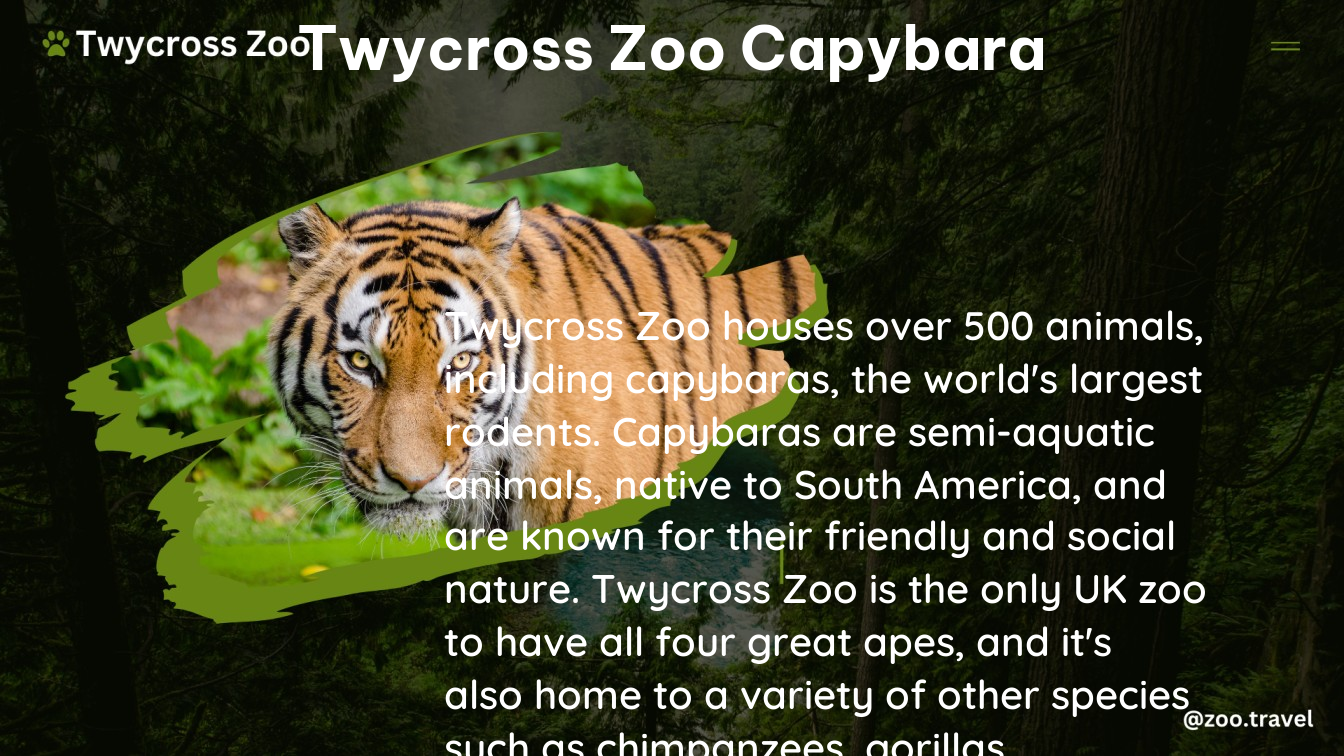Twycross Zoo, a renowned zoological park in Warwickshire, England, is home to a fascinating and unique species – the capybara. As the world’s largest rodent, these semi-aquatic creatures have captured the hearts of visitors from around the globe. In this comprehensive guide, we’ll delve into the captivating world of the Twycross Zoo capybaras, exploring their natural habitat, behavior, and the conservation efforts that make this zoo a must-visit destination.
The Capybaras of Twycross Zoo
Twycross Zoo is one of the few zoos in the UK that houses capybaras, providing visitors with a rare opportunity to observe these remarkable animals up close. The capybara exhibit at the zoo is designed to mimic their natural South American habitat, complete with a shallow pool where they can swim and play.
Habitat and Adaptations
Capybaras are native to the wetlands and savannas of South America, and their semi-aquatic lifestyle is a testament to their remarkable adaptations. At Twycross Zoo, the capybara exhibit features a carefully curated environment that replicates their natural habitat, allowing visitors to witness their unique behaviors and adaptations.
| Adaptation | Description |
|---|---|
| Webbed Feet | Capybaras have partially webbed feet, which aid in their swimming and navigating through the water. This adaptation allows them to move effortlessly in their aquatic environment. |
| Waterproof Fur | The capybara’s fur is coated with a natural oil that helps repel water, keeping them dry and insulated even when submerged. |
| Amphibious Lifestyle | Capybaras are known for their ability to spend extended periods in the water, often resting and socializing while partially or fully submerged. |
Behavior and Social Dynamics
At Twycross Zoo, visitors can observe the capybaras’ fascinating social behaviors and interactions. These highly social animals live in large family groups, known as herds, and exhibit a range of behaviors that showcase their intelligence and adaptability.
- Grazing and Foraging: Capybaras are herbivores and spend a significant portion of their time grazing on a variety of grasses and aquatic plants.
- Communal Resting: Capybaras often gather in groups to rest, with individuals taking turns keeping watch for potential predators.
- Vocalization: Capybaras communicate through a range of vocalizations, including whistles, barks, and grunts, which can be heard throughout the exhibit.
- Grooming: Capybaras engage in extensive grooming behaviors, using their teeth and claws to maintain their fur and skin.
Conservation Efforts at Twycross Zoo

Twycross Zoo is committed to the conservation of capybaras and other endangered species. The zoo’s Conservation Welfare Fund has contributed over £350,000 to various conservation and welfare projects, including initiatives focused on capybara populations in their native South American habitats.
Supporting Capybara Conservation
Twycross Zoo actively supports capybara conservation efforts through various initiatives, including:
- Funding research and monitoring programs to better understand capybara populations and their habitat requirements.
- Collaborating with local communities and conservation organizations in South America to protect capybara habitats and mitigate threats.
- Educating visitors about the importance of capybara conservation and the challenges these animals face in the wild.
By visiting Twycross Zoo and learning about the capybaras, visitors can contribute to the ongoing efforts to protect these remarkable creatures and their natural environments.
Plan Your Visit to Twycross Zoo
Twycross Zoo is open daily from 10:00 am to 5:00 pm, with extended hours during school holidays. Visitors can purchase admission tickets online or at the gate, with various options available, including family tickets, student discounts, and concessions for seniors and disabled visitors.
Whether you’re a wildlife enthusiast, a nature lover, or simply seeking a fun and educational day out, Twycross Zoo and its captivating capybaras are sure to leave a lasting impression. So, plan your visit today and immerse yourself in the wonders of the natural world at this remarkable zoological park.
References:
– Twycross Zoo Animals. (n.d.). Retrieved from https://twycrosszoo.org/explore/animals/
– Capybara – Picture of Twycross Zoo, Atherstone. (n.d.). Retrieved from https://www.tripadvisor.com/LocationPhotoDirectLink-g1041932-d607877-i149706248-Twycross_Zoo-Atherstone_Warwickshire_England.html
– File:Capybara at Twycross Zoo-4.jpg – Wikimedia Commons. (n.d.). Retrieved from https://commons.wikimedia.org/wiki/File:Capybara_at_Twycross_Zoo-4.jpg
– What is Twycross Zoo and its capybaras? | baby capybara. (n.d.). Retrieved from https://www.linkedin.com/posts/babycapybara_does-twycross-zoo-have-capybaras-https-activity-7122094172148297729-fMIK
– Twycross Zoo FAQs. (n.d.). Retrieved from https://twycrosszoo.org/plan/faqs/faqs/what-animals-do-you-have-at-twycross-zoo/
